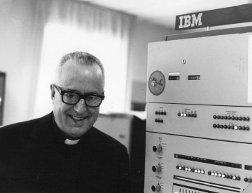Looking Ahead to 2012 and Looking Back to Father Roberto Busa

The rest of the world concentrates its rituals of regeneration and looking ahead in the springtime. It's a peculiarity of the academic calendar that we begin at the end--the fall, the autumn, the dawn of the new school year. The natural world begins imperceptibly slouching into another winter, while the campuses and their departments fill with new cohorts, new ideas, and new initiatives, some emerging for the first time from a summer's gestation with eyes firmly fixed on the horizon.
The ProfHacker blog at the Chronicle of Higher Ed, for instance, ran a pair of forward-looking pieces last week on the new academic year (looking ahead to the next MLA) and the new academic you (getting started in the digital humanities), respectively. And these both came on the heels of the first missive in a two-part report from William Pannapacker on the recent Stanford-based installment of the annual "Big Tent" conference put on by the Alliance of Digital Humanities Organizations. To hear Pannapacker tell it, 2011-12 is going to be another strong growth year for the digital humanities. "[T]he field," he writes, "is growing so fast that the major challenge is managing the proliferation of projects and approaches." And elsewhere, Pannapacker quotes UCSB digital humanities guru Alan Liu on the dizzying prospects of current and forthcoming initiatives that are "quickly approaching the limits of what is graspable by the human mind."
Professor Liu's quip is provocative, of course, but it interests me for a certain historical resonance that is particularly strong this week. His evocation of a hyper-rational applied humanities computing capable of transcending human intelligence is at once excitingly speculative and kind of quaint (in that computer processors have long surpassed the power of the brain by many--but not all--metrics). And as such, it also very much echoes past visions of the computational future, tracing a path back through the social scientific, technocratic, and pop-futuristic prophecies of the early-information society (beyond the eerily prescient mysticism of Marshall McLuhan and the hit-or-miss enthusiasms of Alvin Toffler, see the more reasoned and wide-ranging late-industrial musings of Daniel Bell, Peter Drucker, and Jay Forrester) to some of the earliest visions of applied computing, those of, say, Vannevar Bush and Father Roberto Busa.
Bush, his body of work, and his foundational Atlantic essay, "As We May Think," are widely known. Busa's name is less familiar, but he is generally considered to be the father of humanities computing. When IBM's Paul Tansman wrote in 1957 that "[t]he use of the latest data-processing tools developed primarily for science and commerce may prove a significant factor in facilitating future literary and scholarly studies," he was--in no small part--projecting forward from the work that he had been doing with Busa, a young Jesuit philologist, for nearly a decade.
Susan Hockey describes Busa's trailblazing project in a fascinating chapter of A Companion to Digital Humanities, ed. Susan Schreibman, Ray Siemens:
"In 1949, an Italian Jesuit priest, Father Roberto Busa, began what even to this day is a monumental task: to make an index verborum of all the words in the works of St Thomas Aquinas and related authors, totaling some 11 million words of medieval Latin. Father Busa imagined that a machine might be able to help him, and, having heard of computers, went to visit Thomas J. Watson at IBM in the United States in search of support. Some assistance was forthcoming and Busa began his work. The entire texts were gradually transferred to punched cards and a concordance program written for the project. The intention was to produce printed volumes, of which the first was published in 1974 (Busa, R. Index Thomisticus, 1974- )."
Busa, who passed away last week, is the scholar today's digital humanists have in mind when they say that their field goes back not just decades but generations. In his work, his boldly interdisciplinary methodology, and his unwavering commitment to a project that initially struck even IBM founder Thomas Watson as outrageous (and surely "approaching the limits of what is graspable by the human mind") and would ultimately take decades to complete, Father Busa's inspiration has helped to launch hundreds of DH projects, from Robert Dilligan's computational poetry analyses in the 1970s to the prospective bumper crop of the 2012 MLA in Seattle.
So as we look forward to the bright future of the digital humanities this fall, we would also do well to look back on the career of the field's earliest luminary and continue to be inspired by his example. Here's to another year of pushing boundaries.